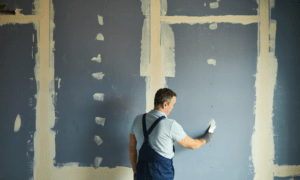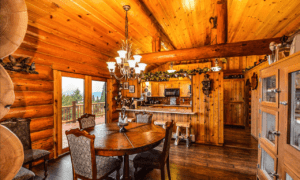Introduction
The Appeal of DIY Container Homes
DIY container homes have gained immense popularity for their affordability, sustainability, and unique design possibilities. In this comprehensive guide, we’ll explore how you can turn shipping containers into a comfortable and stylish living space, all while embracing the DIY spirit.
Sustainability and Affordability
DIY container homes are an eco-friendly and budget-conscious housing solution. By reusing shipping containers and incorporating sustainable building practices, you can create a dwelling that reduces your environmental footprint and saves on construction costs.

Choosing the Right Container
Sourcing and Selecting Shipping Containers
Sourcing the ideal shipping container is the initial and fundamental step in your DIY container home project. Here, we’ll explore the key aspects of finding and selecting the right container to ensure the success of your dream home.
When it comes to sourcing containers, there are several options to consider:
- New vs. Used Containers: Decide whether you want a new or used container. New containers are typically in better condition, while used containers can be more budget-friendly.
- Local Suppliers: Start by looking for local suppliers, as shipping containers can be heavy and costly to transport long distances. Local suppliers often have a range of container types available.
- Online Marketplaces: Online platforms like eBay or specialized container websites can provide a broader selection, but be cautious about shipping costs and ensuring the container’s condition matches the description.
As you explore your options, it’s crucial to consider the following factors:
Quality and Condition:
Inspect the container for rust, dents, and structural integrity. Minor surface rust may not be an issue, but severe corrosion can weaken the structure.
Size and Configuration:
Shipping containers come in standard sizes (e.g., 20-foot or 40-foot). Consider the size that best suits your needs and intended layout.
Budget and Negotiation:
Negotiate the price with the seller and be aware of additional costs, such as delivery or modifications. A well-negotiated deal can save you money.
Once you’ve found a container that meets your criteria, it’s essential to document its condition with photographs and written descriptions. This documentation can be valuable in cases of disputes or insurance claims during the delivery process.
By sourcing the right container and ensuring it’s in suitable condition, you’ll set a strong foundation for your DIY container home project, making the rest of the construction process smoother and more cost-effective.

Design and Layout
Creating a Functional and Aesthetic Space
When it comes to designing your DIY container home, there’s a delicate balance between functionality and aesthetics. In this chapter, we’ll guide you through the process of creating a layout that maximizes space, harnesses natural light, and transforms your shipping containers into inviting, cozy living spaces.
1. Maximizing Space Efficiency
The beauty of container homes lies in their versatility, but effective space utilization is key. Learn how to make the most of every square foot, from utilizing vertical space for storage to creating multi-purpose areas that serve various functions. We’ll provide practical tips for optimizing space without compromising comfort.
2. Harnessing Natural Light
Natural light not only enhances the ambiance but also reduces the need for artificial lighting. Discover strategies for incorporating large windows, sliding glass doors, and skylights into your container home design. Proper window placement can offer stunning views and a bright, cheerful atmosphere.
3. Innovative Room Division
If you desire separate living areas within your container home, we’ll explore innovative room division ideas. From sliding partitions to open shelving, there are numerous creative ways to create distinct spaces while maintaining an open and airy feel.
4. Choosing a Design Style
Whether you lean towards a minimalistic, industrial look or a more traditional, cozy design, we’ll discuss various design styles that complement container homes. Select a style that resonates with your preferences and tailor it to your DIY project.
5. DIY Floor Plans and Interior Design Ideas
Creating a functional and aesthetically pleasing floor plan is essential. We’ll provide DIY floor plans and interior design ideas to kickstart your creativity. These plans include options for single-level and multi-level container homes, open-concept layouts, and clever storage solutions. Get inspired and adapt these ideas to your specific container home project.
Designing your DIY container home is an exciting part of the process, allowing you to infuse your personality and preferences into the space. With careful planning and innovative ideas, you can achieve a container home that’s not only functional but also a reflection of your unique style and needs.

Insulation and Climate Control
Essential Steps for Comfort and Energy Efficiency
When converting a shipping container into a livable space, ensuring comfort and energy efficiency is paramount. Proper insulation and climate control measures are essential to maintaining a comfortable environment throughout the year.
Importance of Insulation
Effective insulation serves multiple purposes in a container home. It helps regulate indoor temperatures, provides soundproofing, and prevents condensation, which can lead to moisture-related issues. Without insulation, your container home could become unbearably hot in summer and excessively cold in winter, making it uncomfortable and potentially unlivable.
Types of Insulation
Several insulation options are available for container homes, each with its unique benefits:
- Spray Foam Insulation: This option provides excellent thermal resistance and seals gaps effectively. It’s a popular choice for container homes but can be relatively expensive.
- Fiberglass Insulation: A more budget-friendly option, fiberglass insulation is easy to install and offers decent thermal performance. However, it’s important to wear protective gear when handling fiberglass.
- Rigid Foam Insulation: This insulation type is known for its high R-value (thermal resistance). It’s a good choice for extreme climates and is also resistant to moisture.
- Recycled or Eco-Friendly Insulation: For a sustainable and cost-effective approach, consider recycled materials like denim or cork, which offer insulation while reducing your environmental impact.
Insulation Installation
Installing insulation in a shipping container involves framing the interior with wooden studs, leaving an air gap between the container walls and the insulation material. This gap helps prevent condensation issues. Insulation is then placed between the studs, and a vapor barrier is added to the interior to further protect against moisture.
Climate Control
Maintaining a comfortable indoor climate goes beyond insulation. Effective climate control methods include:
- Ventilation: Proper ventilation ensures fresh air circulation and reduces indoor humidity. Ventilation can be achieved through windows, vents, and fans.
- Heating and Cooling: For year-round comfort, consider heating and cooling solutions. Ductless mini-split systems or radiant floor heating are effective options for container homes.
- Windows and Shades: Energy-efficient windows, combined with insulated curtains or blinds, help regulate indoor temperatures and save on heating and cooling costs.
By carefully considering insulation and climate control in your container home project, you’ll create a space that is energy-efficient, comfortable, and suitable for year-round living. These essential steps ensure that your DIY container home is a welcoming and sustainable living environment.

Plumbing and Electrical Systems
DIY Solutions for Water and Electricity
Setting up the plumbing and electrical systems in your container home is a critical aspect of ensuring comfort and functionality. Whether you’re connecting to municipal utilities or going off-grid, this chapter will guide you through the process.
Plumbing Solutions for Your Container Home
When it comes to water supply in your container home, there are several options to consider. You can connect to municipal water sources or opt for an off-grid solution. Rainwater harvesting, well water, or water delivery services are alternative methods that allow you to have a sustainable water supply.
For a DIY approach, installing plumbing systems may involve basic knowledge of pipe connections and fixtures. You’ll need to consider water storage tanks, filtration systems, and waste disposal solutions. This chapter will provide you with the information needed to plan and implement your plumbing system effectively.
Electrical Systems for Your Container Home
Electrical systems are another crucial aspect of your container home. Whether you’re connecting to the grid or going off-grid with solar panels and batteries, you’ll need a safe and reliable electrical setup.
DIY electrical work can be complex, so it’s essential to understand the basics of electrical circuits, wiring, and safety. You’ll need to plan the placement of outlets, switches, and lighting fixtures. Additionally, you may decide to incorporate energy-efficient appliances and lighting to reduce your environmental footprint.
Safety and Regulatory Considerations
Safety should be the top priority when dealing with plumbing and electrical systems in your container home. Understanding and following safety protocols is essential to protect yourself, your family, and your property.
Moreover, adhering to local building codes and regulations is crucial. Different regions have specific requirements for plumbing and electrical work, and failing to comply can result in safety hazards and legal issues. This chapter will emphasize the importance of obtaining permits, conducting inspections, and working with professionals when needed.
By addressing safety and regulatory considerations, you’ll ensure that your DIY container home is a secure and compliant living space that meets all necessary standards and provides a comfortable and safe environment for you and your family.

Finishing Touches and Interior Decor
Personalizing Your Container Home
Personalization is the key to making your DIY container home a true reflection of your style and personality. Your home should be a place that feels uniquely yours, and the interior decor plays a significant role in achieving this. Here, we’ll explore various ways to infuse your personal touch into your container home.
When personalizing your container home, consider the following:
1. Selecting Paint Colors: Paint is one of the most powerful tools for personalizing your space. Choose colors that resonate with your aesthetic. Whether you prefer serene pastels, bold and vibrant hues, or a calming neutral palette, your choice of paint can set the tone for your entire home.
2. Choosing Fixtures and Furnishings: The fixtures and furnishings you select should align with your personal style. Whether you lean towards a modern, minimalist look or a more eclectic, bohemian vibe, your choice of lighting, faucets, and furniture will influence the overall atmosphere of your container home.
3. Adding Personal Art and Decor: Personalize your space with art and decor that speaks to you. Display family photos, your own artwork, or pieces collected from your travels. These items can evoke memories and create a sense of connection to your surroundings.
Cost-Effective Decorating Tips
Decorating your container home on a budget is not only possible but also a rewarding creative challenge. Here are some cost-effective decorating tips to help you achieve a stylish and inviting living space without overspending:
1. Upcycling Furniture: Consider giving new life to pre-loved furniture by refinishing, repainting, or reupholstering it. Thrift stores, garage sales, and online marketplaces can be treasure troves for affordable, unique pieces.
2. DIY Decor Projects: Get creative with do-it-yourself decor projects. Craft your own wall art, throw pillows, or decorative items. DIY projects can be a fun way to personalize your home while saving money.
3. Shop Smart: Look for budget-friendly decor items at discount stores, outlet malls, or during sales. Clearance sections often hide great finds at reduced prices.
By personalizing your container home with these tips and tricks, you can transform it into a comfortable and welcoming space that truly represents you. Whether you’re drawn to a particular design style or you prefer a blend of influences, your container home can be a canvas for self-expression and creativity.
Conclusion
The Fulfilling Journey of DIY Container Home Construction
In conclusion, embarking on the journey of building your DIY container home is an exciting and fulfilling endeavor. By sourcing the right container, designing a functional layout, addressing insulation and climate control, setting up plumbing and electrical systems, and adding personal touches, you can create a comfortable and unique living space that suits your lifestyle.
Turning Shipping Containers into Cozy Living Spaces
With the insights and knowledge shared in this guide, you’re well-equipped to turn shipping containers into cozy and inviting living spaces. Embrace the DIY spirit and enjoy the satisfaction of creating a dream home that’s both sustainable and affordable.
If you’re looking for a solution to deal with a noisy neighbor’s generator, check out our article on Home DIY: How to Deal with a Noisy Neighbor’s Generator for some helpful tips.















